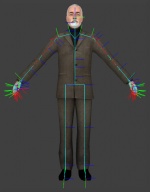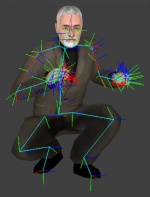Skeletal animation
(Redirected from Skeletal)
Jump to navigation
Jump to search
Skeletal animation is a processor-efficient and relatively simple animation system that can simulate any jointed object, from people to insects to machinery.
The titular skeleton is a hierarchy of jointed but individually rigid bones that are manipulated in the same way as a real skeleton. Vertices are 'enveloped' to the appropriate bone and move with it; the bone in turn moves with the bones above it (e.g. the hand follows the forearm). Polygons that cover joints between bones stretch and compress as the skeleton moves.
Bones can be controlled with canned animation, real-time physics, and/or inverse kinematics.
Limitations
- A bone is rigid
- The vertices enveloped to any given bone move as one unit. A skeletal animation cannot move them relative to each other (a flex animation can).
- A bone has only one parent
- A skeletons are organised into trees, branching out from a root. Webs/meshes of bones are not possible.
- Skeletons require hierarchy
- While it is theoretically possible to animate gasses or liquids with bones, it's an inefficient and overwrought solution. Use particles to create such effects.
See also
- Flex animation morphs vertices directly (used for faces/lips)
- Vertex animation is keyframed vertex motion
- are used to animate clouds or streams of objects
- Animated textures change the appearance of 2D surfaces
SetSequence()is used by programmers to play skeletal animations
External links
 Skeletal animation on Wikipedia
Skeletal animation on Wikipedia

